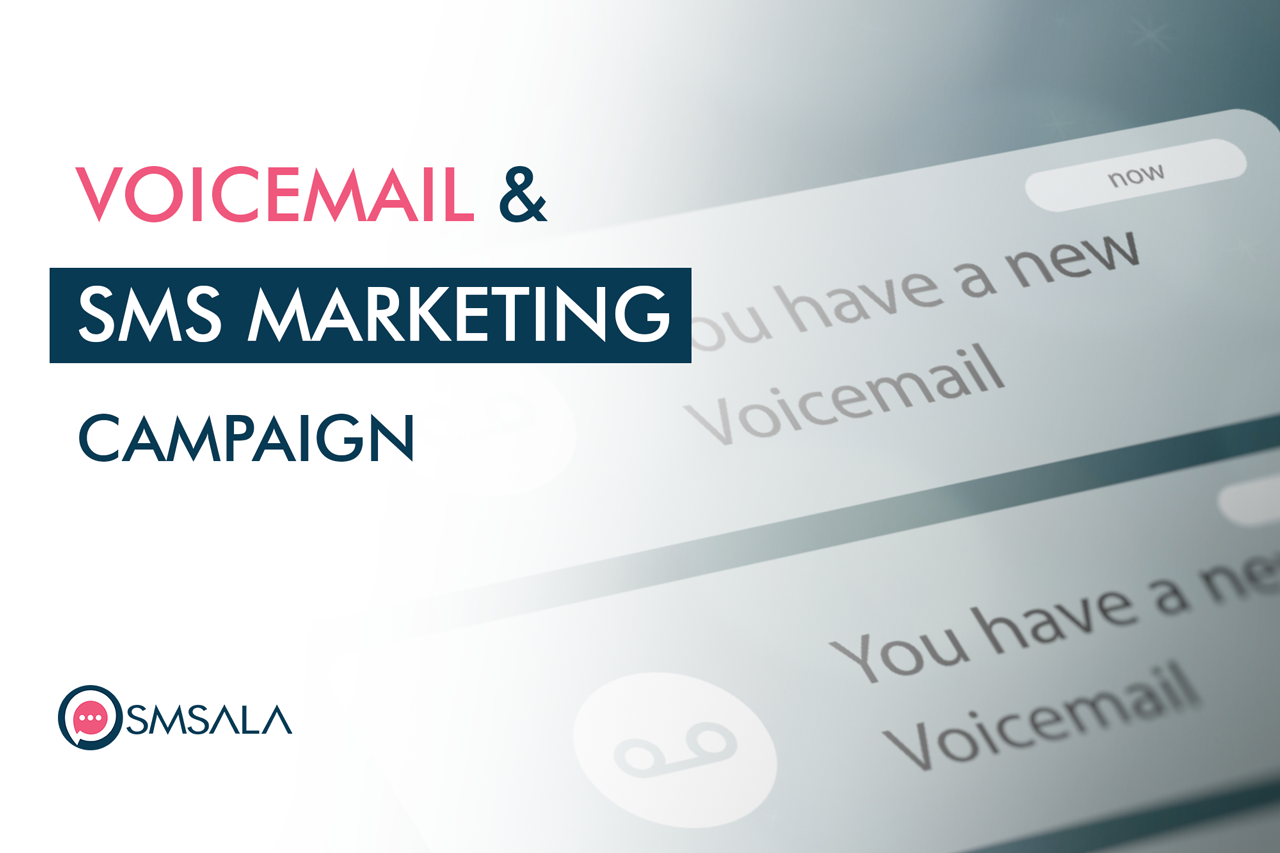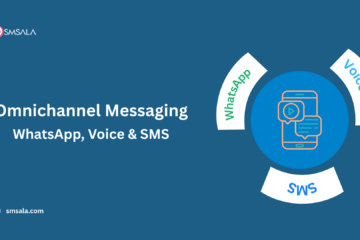If you’re looking for techniques that can help grow and expand your customer reach, you should harness the power of voicemails and SMS messages. But why?
A voicemail is a strategic pre-recorded audio message delivered right into your customers’ and prospects’ inboxes. It allows your audience to listen to your message whenever they want. This is why voicemails are said to have a whopping open rate as high as 95%, much higher than emails.

In addition, most voicemail companies offer voicemail drops that are ringless. This means dropping a voicemail won’t cause phones to ring. This makes it a less intrusive approach to reaching out to your audience.
Like voicemails, SMS messages boast an open rate as high as 95%, much higher than emails. Plus, almost 100% of mobile phones in the market are SMS-enabled. This makes it a channel that offers the most extensive audience reach possible.
In fact, some of today’s most prominent brands heavily invest in SMS marketing because more than 90% of text messages are opened within three minutes after being sent.
However, you won’t be able to achieve marketing success right away if you won’t use voicemails and SMS to your advantage. Read on to learn how to execute your voicemail and SMS marketing campaigns the right way.
Tips For Leaving The Perfect VoicemailÂ
Here are some best practices when leaving a high-quality voicemail. Follow these to get responses from your recipients.
- Keep Your Voicemails Around 20-30 Seconds Long
An ideal voicemail should be between 20 and 30 seconds—not too short and not too long. But why should you do so?
Apparently, customers and prospects won’t spend time listening to a long voicemail, especially if it’s from a number they don’t even know. That said, pushing over the 30-second mark would get your message deleted instantly.
The same goes for overly short voicemails because such messages don’t appear substantial. They’ll most likely end up getting deleted.
So, to avoid wasting your time and effort, go for the sweet spot. A voicemail within 20-30 seconds sparks curiosity without being too demanding.
- Lead With Relevant Information
Most sales agents are so declarative when creating a message. They often use phrases like, ‘My name is James Peters, and I’m from ABC Digital Creations,’ as their starting line.
Yes, it’s a direct approach, yet it’s far from being effective. Why? Because it’s so sales-like. Once the prospect realizes that, expect your voicemails to be deleted immediately. Thus, it’s important to lead your audience with something relevant to them (e.g., thought-provoking questions).
- Ask Questions You Wouldn’t Include In Emails
If voicemails sound like your emails, your chances of getting responses will reduce significantly. That’s why it’s crucial to make your messages different by posing questions specially reserved for voicemails.
Although both messages have to be customized to a particular audience, voicemails must be super-specific. When you write an email, you may ask a customer for an appointment or feedback on something they bought. While still personalized to the customers, such messages can be reused with another 1000 prospects.
However, the questions you pose in your voicemails must be specific so they won’t be reused with another prospect. For example, if you’re selling work automation technology, you may ask the recipient what related software they currently use.
If your questions are more specific, you’re more likely to receive a response from your recipients. Ultra-specific questions make customers and prospects feel more responsible for answering you.
- Avoid Using Traditional Closing Lines
Traditional closing lines are so generic. They can’t make customers and prospects feel more responsible for responding to your messages. That said, here are some examples of traditional closing lines that you might want to avoid:
- ‘I’ll call you back on _ date.’
- ‘Please call back after hearing this message.’
- ‘Please reply after this message.’
- ‘Can’t wait to call you again next time.’
- ‘I look forward to hearing from you.’
Instead of using these closing lines, try asking a specific question and end your message.
- Use Your Natural Voice
Sales agents are trained to be enthusiastic when talking to customers and prospects. Unfortunately, they often end up raising their voices to an unnatural tone. Such a tone of voice can make a call uncomfortable, generic, and too salesy.
Experts recommend starting voicemails with a natural tone of voice and slowly going lower. This makes customers and prospects feel at ease during the call. Without a fake tone of voice, they’ll be able to understand what you’re asking and how it’s meaningful for both of you.
- Send Voicemails At The End Of The Day
The chances to connect with your customers and prospects via voicemails increase as the day progresses. So, it’d be best to schedule your messages at the end of the day. Why? This is because of a phenomenon called the serial position effect.
The serial position effect is a psychological phenomenon indicating that people are more likely to remember the first and the last items on a list. This means you want to be the first or the last thing they hear to grab their attention.
Think about this: if you receive a sales message as early as 9:00 a.m., how will you respond to it? It might be one of the best voicemails you’ve ever heard, but you have other tasks to complete. And by the time you’ve got free time to do so (most likely at the end of the day), you’ve probably forgotten about it.
On the other hand, if you listen to a voicemail around 5:00 p.m., your shift is most likely complete. You might be able to send an email that night or return a call the next day.
- Split Your Voicemails Into Two
You may consider leaving two separate voicemails with one core message. Instead of sending one 30-second audio message, create and send a 20-second voicemail and follow it up with a 10-second one. But what should the second voicemail contain, in case you’re wondering?
The second voicemail should contain the essential details you’ve forgotten to mention in the first one. Here’s an example you might want to consider:
- First Voicemail: ‘Hi, Antoinette! Recently, I attended one of FreeFlowing’s webinars. I didn’t receive any emails, so I wonder if you already have a tool that enables you to automate your processes. According to our research, those who use an automation tool are 50% more efficient. What tool do you currently have, if any?’
- Second Voicemail: ‘Antoinette, I forgot to leave my contact details. This is Mary Parks from Automate 101 Inc. You can reach me at 1-800-185-5410. Thank you!’
Voicemail splitting offers a few benefits. It makes your voicemail more memorable and less rehearsed. This will encourage your customers and prospects to trust you more.
Tips For An Effective SMS Campaign
Here are some best practices that may help you leverage the power of SMS marketing:Â
- Ask For Permission
Before you send a sales or promotional message, ask your recipient’s permission by sending a one-time message called opt-in.
Here’s an example of a compelling opt-in message:
‘Hi! Thanks for reaching out to The Landscape Project. If you want to receive exclusive deals and offers in the future, please reply YES to give us your consent.’
Start your request with full disclosure regarding the kinds of messages they might receive once they opt-in. After getting their consent, make sure not to abuse it. It’d be best to use SMS campaigns when sending critical or time-sensitive information.
Also, don’t forget to include opt-outs for every message you send. Opt-outs allow subscribers to stop receiving sales messages and offers.
Here’s an example of a sales message with an opt-out feature:
‘[Company Name] – There are some items left in your cart. Check them out before they’re gone. [abandoned cart link] Unsubscribe? Reply STOP’
- Mention Where You Come From
Your recipients should know who you are and where you come from. If you fail to introduce yourself, they might not be able to understand the purpose of your message. They’ll probably delete your message immediately.
Here’s an example you might want to try:
‘Thank you for ordering from The Landscape Project. We will send you a message once shipped. You may check your order details in the link provided [link]. Unsubscribe? [unsubscribe link]’
- Add Clear Calls To Action
Calls to action (CTAs) encourage consumers to take the steps you want them to do, whether to subscribe to your newsletter or grab your offers. But make your CTAs as clear as the sun, so your customers understand what to do next.
Here’s an example of a message with CTA:
‘This green month, we’ll give tons of prizes and surprises! Text LANDSCAPE to 525354 to earn a chance to win free landscaping services for the entire year.’
Other examples include:
- Click [link] to receive timely and exclusive offers
- Use [code] when you checkout before 11:59 pm today for a 20% discount on branded deals.
- Check [link] before midnight to grab our free shipping and other exclusive deals.
- Answer our special survey [link] to earn a chance to win exclusive prizes.
It’s common for marketers to use capital letters when it comes to CTAs and short codes. This is to ensure that they stand out in the message. If you want to boost audience engagement, make sure to prioritize your CTAs in every message you send.
- Send SMS At The Right Time
You may have a great SMS message, but what will you do if it fails? If that’s the case, don’t blame your message but the time you send it. So, when should you send your SMS campaigns?
Here are the Best Times to send an SMS message:
- On weekdays, between 9:00 a.m. and 12 noon – This is when most people check their notifications and messages before they start working.
- On weekdays, between 5:00 p.m. and 9:00 p.m. – By this time, people are ready to leave their workspaces. This gives them a lot of time to browse their smartphones.
- On weekends, between 10:00 a.m. and 12 noon – Weekends are a great time to send SMS messages because most people are busy using their smartphones while resting.
- On Sundays, between 4:00 p.m. and 7:00 p.m. – By this time, people prepare for the upcoming work week. They probably have time to read your messages:
Be sure to avoid sending a message on Mondays to avoid the competition.
- Keep Your SMS Short And Sweet
Most people read their messages within three minutes of receipt. This makes it an excellent way to connect and interact with your customers. But to make your message work, be mindful of its length.
It’s best to keep your message short yet substantial. Avoid writing an overly long one; you’re from being a novelist.
A maximum of 160 characters is enough to create a high-quality, on-point message that motivates prospects to respond immediately. If you’re sending a link, use a link shortener to avoid wasting characters.
- Personalize Your Message
Bulk texting is an effective strategy to promote products and services. It saves time, reaches more people, and increases efficiency. However, such messages should sound like day-to-day conversations to work. This is where personalization comes in.
Personalization is essential not only in email marketing but also in SMS. It shows your audience that you understand their needs. This makes consumers more engaged and driven, leading to higher open rates.
Here are some tips for personalizing your SMS messages:
- Use the first name of your recipients like you personally know them.
- Use conversational language.
- Send messages during business hours.
- Write simple messages and avoid complex ones.
- Include a link when you send a message.
- Target the pain points of your customers when you create a message.
- Include CTAs (e.g., ‘give us five stars’ or ‘check this out!’)
Follow these simple tips to create a personalized message and make your audience feel like you’re communicating with them and only with them.
Final Thoughts
Voicemails and SMS are powerful strategies to grow and expand your customer reach. Both have an extremely high open rate, which makes them excellent tools for interacting and engaging with customers. Use this guide and apply the best practices discussed above to create a successful voicemail and SMS marketing campaign.


